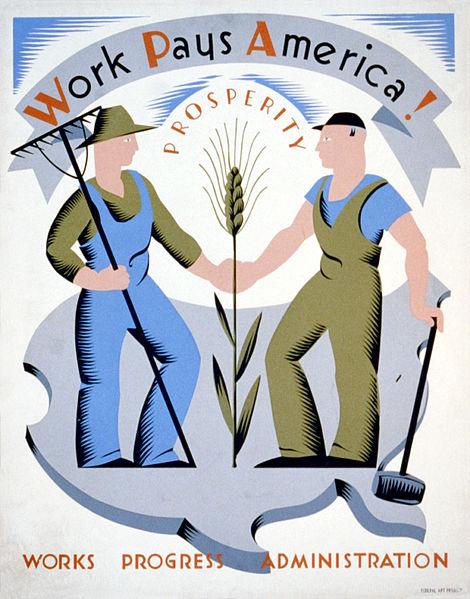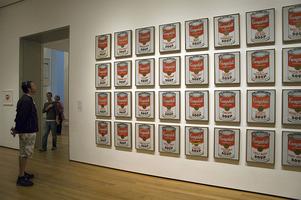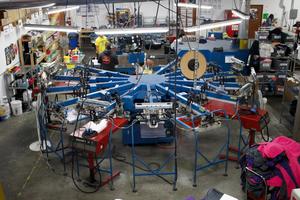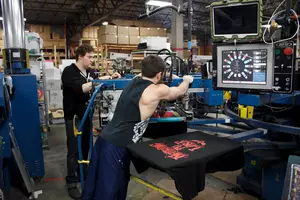Serigraphy: Screenprinting Gets Classy
By: Rachel T, rachel.t@annarbortees.com
almost 7 years
As discussed in our previous blog, Ready for the Closeup: Photographic Screens, screen printing was a major industry by the 1930’s. In 1933, Franklin Delano Roosevelt created, as part of the New Deal, the Work Projects Administration (WPA). He created the WPA to help employ Americans during the Great Depression. In fact, the WPA became one of the first U.S. Government programs to support the arts. Many workers screen printed screen the WPA's very own posters and signs. However, some screen printers desired to distance artistic printing from its' industrial process roots. So, they renamed screen printing the more hoity-toity sounding “Serigraphy”.

WPA poster encouraging laborers to work for America
Seri-what?
Serigraph comes from the latin prefix “seri”, meaning silk, and also the Greek (to sound extra pompous) “graphos or graphein”, meaning to write. In 1940, a group of artists began the National Serigraph Society. Their goal was to display and promote serigraphy throughout the world. Screen printing reached new heights as a respected art with hamburger eating pop artist Andy Warhol. His experiments with screen printing in the 1960’s brought it to the mainstream.
Before Andy Warhol, most screen printers kept their screen printing techniques as “trade secrets”. Like the ancient Chinese, they wished to preserve their hold on the industry. Andy Warhol popularized screen printing by using other pop icons of American culture. Elvis Presley, Marilyn Monroe, and even Campbell's soup cans became printed masterpieces. With screen printing, Warhol could print large quantities of his work. This helped spread his images around the world.
What about industry?
Around this time, screen printing also gained traction in garment fabrication. Before 1960 most screen presses could only handle one layer of printing. A printer would load a screen into position and push the ink through. Then if the design needed another screen or color, the printer would swap the old screen out for a new one. In 1960, Michael Vasilantone filed a patent for a rotary press or rotary garment. This machine could apply many layers and colors to a print in quick succession, boosting production speed.
Modern screen printing...
With the integration of computers into mainstream production, screen printing became even easier. Artists can create their design in Photoshop, Illustrator, or other image creation software. Then they typically separate the design into one color per screen.
Next, a machine prints the design on transparent films. The films are then overlaid on the screens and exposed to UV light. Some businesses even use a special machine called a Direct to Screen (DTS) instead of films. After all the screens are exposed and washed out, they are loaded into a manual or automated press. Some automated presses can move a garment through more than a dozen different screens. This allows for more complex designs and much faster printing.
The improvements of screen printing’s speed, accuracy, and detail are staggering. Yet, the fundamentals have changed very little over the years. People still enjoy printing their own works of art much like their ancestors in ancient caves. Given its’ long history, it seems unlikely that screen printing has many more earth-shattering changes in store, but its’ sound past will keep us printing into the future!
Want to join in the future of screen printing yourself? Check out our job listings and fill out an application today!
Enough history? Want custom shirts now?
Yes! How do I start?References
- http://www.ooshirts.com/guides/History-of-Screen-Printing.html
- http://www.visual-arts-cork.com/prehistoric/hand-stencils-rock-art.htm
- http://www.brighthub.com/multimedia/publishing/articles/105324.aspx
- http://revolverwarholgallery.com/andy-warhol-screenprints-process-history/
- https://www.dfcscreenprinting.com/blog/the-history-of-silk-screen-printing.html
- http://www.visual-arts-cork.com/printmaking/screen-printing.htm
- https://en.wikipedia.org/wiki/Silk
- https://en.wikipedia.org/wiki/Screen_printing
- http://www.gwent.org/gem_screen_printing.html#history
- Book - Mental Floss History of the World
- https://en.wikipedia.org/wiki/Mimeograph
- http://homepage.usask.ca/~nis715/scrnprnt.html
Tags: #screen printing, #learn about printing, #history, #america, #employment





